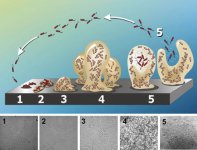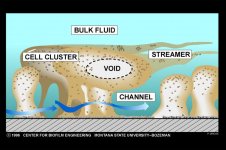I most certainly agree. However, unlike the ocean that has the abyss to dilute and degrade nutrients, our tanks are so minuscule water volume wise.I'm definatly not considering going skimmerless, my feeding habits wont allow it even with my 25% waterchanges once a week and 50% once a month. I feed my tanks 5-7 times a day of various food. (there is more fish/coral coral food in my feezer and in my fish closet than most people own peole food) I firmly believe a lot of the corals in our systems are malnourished/underfed due to our inability to properly export the by products, true rapid growth can only be acheived by providing the proper diet for all these critters, damn hard to acheive when the by products of half of what they need for optimal growth would crash most systems because we cant get rid of the waste/unconsumed foods before it breaks down, this is where having diverse microfauna and my insane waterchange ritual as well as far overskimming my tank comes into play.
By overskimming you are definately removing any plankton/microfauna you add or have (not bacteria so much) and many of the nutrients they need for growth. As you mention it is a toss up/cost vs benefit question.Basicly the whole basis of the conversation was on the fact that I WAY over skim and was wondering if I was doing detriment to ceartain populations of microfauna and bacteria by way overskimming, but the overall conclusion I have drawn is any detriment is negligable compared to the benifit of removing excess micro foods and waste before they break down, and contribute to pollution.
I sometimes turn off my skimmer. I do it when I notice that it isn't pulling out much skimmate as normal. I also turn it off for 24 hour periods of time.
These food I am assume are live, therefore, they are not organic waste until they die. I would definitely turn off your skimmer for a period of time to allow contact between the food and the "mouth" to occur.often peole who try to mimic my feeding habits or even feed once a day end up with horrible algae problems and I have no nuisance algae to speak of (what I am stating here is that my grazer crew can easily handle the growth of algaes in my display, not that it doesnt form). by feed my tank i dont mean feed my fish 5-7 times a day, I am feeding lots of micro foods, cyclops, dapnhia, home made foods, several algae foods, and so on rotating what gets fed to ensure if something doesnt utilize a ceartain food it doesnt have to wait long to get one it can.
It's too bad that I couldn't get a water sample from your tank when I was doing the planktonic bacterial study. Your tank seems like it would have been a great addition, to see if you are indeed achieving nature levels of planktonic bacteria or not.free floating bacteria is also a food I want available to my corals so if skimming is a serious detriment to free flating bacteria I would consider, shutting down my skimmer for one day a week then kicking up the sand bed to send bacteria into the water column to make the bacteria available for the corals that consume it. before restarting the skimmer. (now this is again where your opinion really makes a difference for me) I have no way of guaging or knowing how much the overskim capacity diminishes the free floating bacterial levels in the tanks overall volume, if you were to say its most likley negligable I would continue to leave my skimmer running while I kick up my sand bed, if you thought that it reall cut down on the available bacteria I would probably shut my skimmer down 50% of the time when i was kicking up my sand bed. I stirr up my sand bed to release detritus for filtration too, so I would let it skim every other time I stirr my sand bed.
what are your thoughts on that?
You are not going to kick up bacteria by disturbing a SSB. You will kick up organic waste however.
Bacteria can live as biofilms. I have added two artist representation of what they look like below. From these biofilms, planktonic bacteria are going to be constantly released to the water column. These communities will be all over the live rock. They are going to live this way based on nutrients, as nutrients increase the population increases, and individual bacteria will be released from the biofilm to venture off to find a new home and start a new community. Your only action to increase the planktonic bacterial content would be to increase your nutrients, since the bacteria are already able to do the job of getting into the water column themselves.
Attachments
Last edited:







